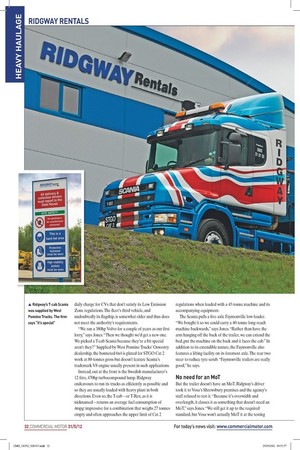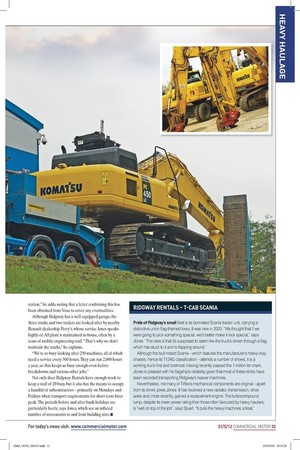RIDGWAY RENTALS
Page 22

Page 24

Page 25

Page 26

Page 27

If you've noticed an error in this article please click here to report it so we can fix it.
Meet the heavyweight haulier
Using heavy trucks to move its plant hire equipment around the country keeps one Shropshire company in with the big boys
Words: Tim Deakin Images: Tom Cunningham A small village in Shropshire is perhaps an unlikely place to find a plant hire company whose equipment regularly works from Land’s End to John O’Groats, but sleepy St Martin’s – a couple of miles east across the A483 from Oswestry – has been home to Ridgway Rentals for the past four years.
Ridgway’s hire fleet numbers 250 machines and it uses a trio of trucks to move all but one. “We’re not lorry people,” says plant director Stuart Jones, whose grandfather founded the business by selling JCBs in the 1960s. “We’re a company that needs trucks to move our machinery. That’s all they do: move our own stuff around.” Most of the hire operator’s equipment weighs between 13 tonnes and 45 tonnes. “We have a high-reach machine that is about 70 tonnes,” says Jones, “but we can’t move that ourselves.” Of the company’s three trucks, two are heavy-duty, double-drive tractor units pulling similarly robust Faymonville step-frame low-loaders, of which Jones speaks highly.
Losing weight the smart way
The third member of the fleet, a 6x2 Iveco Stralis rigid with plant body, does not draw such acclaim. “We had it built from scratch so we could carry 16 tonnes,” explains Jones. “It’s got alloy wheels, a lifting axle and the body was purpose-built to keep the weight down. We nearly ordered it without cab air-conditioning because that would have saved a 60kg, but we gave in on that.” The Iveco’s role is to carry a 13or 14-tonne machine along with accompanying equipment, at which point it is almost at its 26,000kg maximum gross weight. Unfortunately, it has done rather less plant shifting than Jones would have liked because of an intermittent electrical fault.
All equipment is bought new. Plant is generally cycled out of the fleet at between three and five years, while trucks, says Jones, remain in service for as long as they are reliable. For this reason, he will probably bid a less than fond farewell to the Iveco once its warranty period expires.
A much more dependable member of Ridgway’s fleet is a Renault Premium 6x4 tractor unit, which features air suspension on the rear bogie and usually runs coupled to a three-axle trailer. This came from Renault dealer Perry’s of Gobowen as a cancelled order, having originally been specified to pull a tipping trailer. “At the time we bought the Renault [three years ago] we were hiring in extra haulage on a daily basis,” explains Jones. “It was a good price; a driver we knew had become available and the dealer is next door. Everything slotted into place nicely.” The French tractor has a 450hp Volvo engine coupled to running units, also from Sweden, and has proved reliable. Originally plated to run at a maximum of 65 tonnes, it has since been uprated to 80 tonnes, although the Premium’s bread and butter work is moving 35-tonne machines.
Ridgway’s trucks are employed to move the company’s equipment but they undertake work for others occasionally, says Jones, who would like to do more in this field. “We could buy another truck then,” he comments.
Working closely with the customer
Predictably, most jobs see Ridgway’s trucks visiting building sites. “Quite often, sites have a different idea of what they want compared to what’s actually possible,” notes Jones. “They’ll ask you to unload off the side of the trailer, or deliver at a time when the police won’t allow access. We have to work with the customer and come up with an alternative that suits everyone.” Ultimate responsibility for making decisions regarding loading and unloading lies with Ridgway’s drivers, who are experienced in plant movement and have received comprehensive training in safe loading, unloading and securing equipment.
“Drivers have to know what they can and can’t do without breaking something,” says Jones, adding that he always backs his staff. Ridgway’s largest piece of equipment is worth about £500,000 and a 45-tonne machine commands a price of £400,000 when new.
Although rural Shropshire seems an unusual place from which to run trucks carrying heavy plant, Jones says it isn’t a problem for Ridgway. “It’s surprising; Shropshire’s a lot more central than people think. We’re an hour from Manchester, an hour and a half from Birmingham and four-and-a-half hours from London.” And the often-debated 40mph limit for LGVs on single-carriageway roads isn't an issue either. “We’re often limited [to less] under STGO Cat 2 regulations anyway,” he says. “Ours will always be the slowest vehicles on the road.” For combinations running overwidth and/or overlength, speed limits are significantly reduced and can be as low as 40mph even on motorways. Escorting duties are handled in-house.
More of a headache can be the process of planning routes, although the advent of internet-based software that automatically notifies the relevant authorities has expedited the process considerably. Gone is the need to trawl through a collection of books to plot a suitable course, followed by the similarly laborious task of faxing details to all those agencies and other local government bodies which need to know before the move takes place.
Still problematic is attempting to reach central London, says Jones. “There are so many authorities you have to notify, and each one doesn’t seem to know what the others know.” Notwithstanding the Metropolitan Police and Transport for London (TfL), problems are also experienced with satisfying Network Rail and London Underground when planning a job to the capital. The latter is often concerned about the effect a combination weighing up to 80 tonnes may have on its old tunnels, some of which are merely metres below the road surface.
Only Ridgway’s rigid Stralis and Renault tractor unit can undertake jobs to London without falling foul of TfL’s daily charge for CVs that don’t satisfy its Low Emission Zone regulations. The fleet’s third vehicle, and undoubtedly its flagship, is somewhat older and thus does not meet the authority’s requirements.
“We ran a 380hp Volvo for a couple of years as our first lorry,” says Jones. “Then we thought we’d get a new one. We picked a T-cab Scania because they’re a bit special aren’t they?” Supplied by West Pennine Trucks’ Oswestry dealership, the bonneted 6x4 is plated for STGO Cat 2 work at 80-tonnes gross but doesn’t feature Scania’s trademark V8 engine usually present in such applications.
Instead, out at the front is the Swedish manufacturer’s 12-litre, 470hp turbocompound lump. Ridgway endeavours to run its trucks as efficiently as possible and so they are usually loaded with heavy plant in both directions. Even so, the T-cab – or T-Rex, as it is nicknamed – returns an average fuel consumption of 4mpg: impressive for a combination that weighs 27 tonnes empty and often approaches the upper limit of Cat 2 regulations when loaded with a 45-tonne machine and its accompanying equipment.
The Scania pulls a five-axle Faymonville low-loader. “We bought it so we could carry a 40-tonne long-reach machine backwards,” says Jones. “Rather than have the arm hanging off the back of the trailer, we can extend the bed, put the machine on the back and it faces the cab.” In addition to its extendible nature, the Faymonville also features a lifting facility on its foremost axle. The rear two steer to reduce tyre scrub. “Faymonville trailers are really good,” he says.
No need for an MoT
But the trailer doesn’t have an MoT. Ridgway’s driver took it to Vosa’s Shrewsbury premises and the agency’s staff refused to test it. “Because it’s overwidth and overlength, it classes it as something that doesn’t need an MoT,” says Jones. “We still get it up to the required standard, but Vosa won’t actually MoT it at the testing station,” he adds, noting that a letter confirming this has been obtained from Vosa to cover any eventualities.
Although Ridgway has a well-equipped garage, the three trucks and two trailers are looked after by nearby Renault dealership Perry’s, whose service Jones speaks highly of. All plant is maintained in-house, often by a team of mobile engineering staff. “That’s why we don’t maintain the trucks,” he explains.
“We’re so busy looking after 250 machines, all of which need a service every 500 hours. They can run 2,000 hours a year, so that keeps us busy enough even before breakdowns and various other jobs.” Not only does Ridgway Rentals have enough work to keep a staff of 20 busy, but it also has the means to occupy a handful of subcontractors – primarily on Mondays and Fridays when transport requirements for short-term hires peak. The periods before and after bank holidays are particularly hectic, says Jones, which see an inflated number of movements to and from building sites. ■
RIDGWAY RENTALS – T-CAB SCANIA
Pride of Ridgway’s small fleet is its bonneted Scania tractor unit, carrying a distinctive union flag-themed livery. It was new in 2003. “We thought that if we were going to pick something special, we’d better make it look special,” says Jones. “The idea is that it’s supposed to seem like the truck’s driven through a flag, which has stuck to it and is flapping around.” Although the bull-nosed Scania – which features the manufacturer’s heavy-duty chassis, hence its T124G classification – attends a number of shows, it is a working truck first and foremost. Having recently passed the 1 million km mark, Jones is pleased with his flagship’s reliability given that most of these klicks have been recorded transporting Ridgway’s heaver machines.
Nevertheless, not many of T-Rex’s mechanical components are original – apart from its driver, jokes Jones. It has received a new radiator, transmission, drive axles and, most recently, gained a replacement engine. The turbocompound lump, despite its lower power rating than those often favoured by heavy hauliers, is “well on top of the job”, says Stuart. “It pulls the heavy machines a treat.”
GETTING OLDER
The Scania may be getting older, and has been worked hard in the meantime, but is not about to be put out to pasture. “We’ll keep spending money on it,” explains Jones, who adds that the cost of new units to a similar specification has increased. He is also wary of more modern vehicles’ increased reliance on electrics. Even when its time comes, the Scania will live on through a model shortly to be released by Corgi. “We were chuffed it asked us,” says Jones, who had the T-cab taken to south Wales to be measured and photographed by the diecast manufacturer. The real thing’s operator is destined to be the model’s biggest purchaser: Ridgway’s plant director has ordered 50 pieces.













































